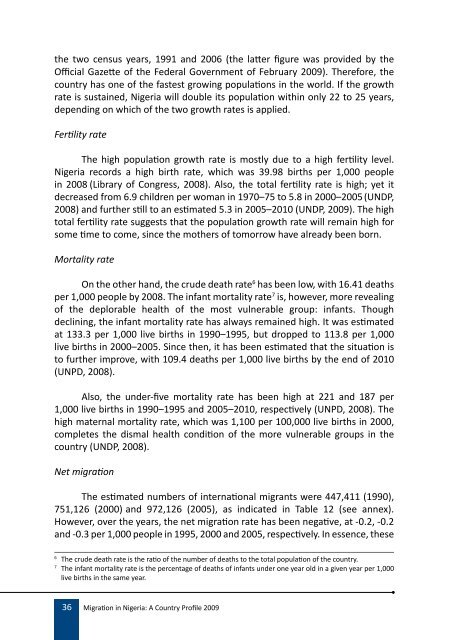Migration Profile on Nigeria - IOM Publications - International ...
Migration Profile on Nigeria - IOM Publications - International ...
Migration Profile on Nigeria - IOM Publications - International ...
Create successful ePaper yourself
Turn your PDF publications into a flip-book with our unique Google optimized e-Paper software.
the two census years, 1991 and 2006 (the latter figure was provided by the<br />
Official Gazette of the Federal Government of February 2009). Therefore, the<br />
country has <strong>on</strong>e of the fastest growing populati<strong>on</strong>s in the world. If the growth<br />
rate is sustained, <strong>Nigeria</strong> will double its populati<strong>on</strong> within <strong>on</strong>ly 22 to 25 years,<br />
depending <strong>on</strong> which of the two growth rates is applied.<br />
Fertility rate<br />
The high populati<strong>on</strong> growth rate is mostly due to a high fertility level.<br />
<strong>Nigeria</strong> records a high birth rate, which was 39.98 births per 1,000 people<br />
in 2008 (Library of C<strong>on</strong>gress, 2008). Also, the total fertility rate is high; yet it<br />
decreased from 6.9 children per woman in 1970–75 to 5.8 in 2000–2005 (UNDP,<br />
2008) and further still to an estimated 5.3 in 2005–2010 (UNDP, 2009). The high<br />
total fertility rate suggests that the populati<strong>on</strong> growth rate will remain high for<br />
some time to come, since the mothers of tomorrow have already been born.<br />
Mortality rate<br />
On the other hand, the crude death rate 6 has been low, with 16.41 deaths<br />
per 1,000 people by 2008. The infant mortality rate 7 is, however, more revealing<br />
of the deplorable health of the most vulnerable group: infants. Though<br />
declining, the infant mortality rate has always remained high. It was estimated<br />
at 133.3 per 1,000 live births in 1990–1995, but dropped to 113.8 per 1,000<br />
live births in 2000–2005. Since then, it has been estimated that the situati<strong>on</strong> is<br />
to further improve, with 109.4 deaths per 1,000 live births by the end of 2010<br />
(UNPD, 2008).<br />
Also, the under-five mortality rate has been high at 221 and 187 per<br />
1,000 live births in 1990–1995 and 2005–2010, respectively (UNPD, 2008). The<br />
high maternal mortality rate, which was 1,100 per 100,000 live births in 2000,<br />
completes the dismal health c<strong>on</strong>diti<strong>on</strong> of the more vulnerable groups in the<br />
country (UNDP, 2008).<br />
Net migrati<strong>on</strong><br />
The estimated numbers of internati<strong>on</strong>al migrants were 447,411 (1990),<br />
751,126 (2000) and 972,126 (2005), as indicated in Table 12 (see annex).<br />
However, over the years, the net migrati<strong>on</strong> rate has been negative, at -0.2, -0.2<br />
and -0.3 per 1,000 people in 1995, 2000 and 2005, respectively. In essence, these<br />
6 The crude death rate is the ratio of the number of deaths to the total populati<strong>on</strong> of the country.<br />
7 The infant mortality rate is the percentage of deaths of infants under <strong>on</strong>e year old in a given year per 1,000<br />
live births in the same year.<br />
36 <str<strong>on</strong>g>Migrati<strong>on</strong></str<strong>on</strong>g> in <strong>Nigeria</strong>: A Country <str<strong>on</strong>g>Profile</str<strong>on</strong>g> 2009

















